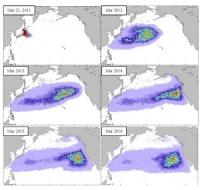Respect urged for Japan's tsunami flotsam landing on U.S. coastlines
 Model predicting travel of the tsunami debris. University of Hawaiʻi at Mānoa
Model predicting travel of the tsunami debris. University of Hawaiʻi at Mānoa
Up to 25 million tons of debris from the earthquake, tsunami and nuclear disaster that hit Japan in March 2011 could eventually reach U.S. coastlines, according to oceanographers.
A floating black 55-gallon drum was found by a cleaning crew on a beach at the northwest tip of Washington state recently. What's interesting about the flotsam is that it is the first known bit of debris from the March 11, 2011 tsumnami that hit Japan to land on a U.S. beach.
Curtis Ebbesmeyer and Jim Ingraham, oceanographic consultants say that people should be on alert for more floating debris and that they should treat it with respect beacuse it could be valuable to Japanese who were affected by the tsunami.
"All debris should be treated with a great reverence and respect," Ebbesmeyer told an audience in Port Angeles, Washington. Anything that’s found by beach combers should be left in place and authorities called, especially any items that could be identified by victims of the Japanese tsunami.
“If the debris has any kind of identifiable marking, such as numbers or Japanese writing, it may be traceable,” Ebbesmeyer said. “Families in Japan are waiting to hear of any items that may have been associated with their loved ones.” Ebbesmeyer also warned that the debris could be contaminated by radiation.
The flotsam could include fishing boats, houses, car parts and possibly human remains, Ebbesmeyer said. Some floating masses could be a hazard to boats and ships, and some shipping lanes have been rerouted around the debris, according to Ebbesmeyer.
Up to one-quarter of the 100 million tons of debris from Japan is expected to make landfall on U.S. beaches from Alaska to California. Traveling in a current, flotsam moves at speeds from 7 to 20 miles per hour, Ebbesmeyer said.
ABCNews.com reported in October that a Russian training ship had encountered a "1,000-mile-long mass of tsunami debris" in September near Midway Island, a U.S. territory about 1,700 miles from Hawaii.
Read more:
First debris from Japanese earthquake/tsunami reaches Olympic Peninsula
Video:
Presentation by Oceanographers Ebbesmeyer and Ingraham given at Peninsula College



 del.icio.us
del.icio.us Digg
Digg












Post your comment